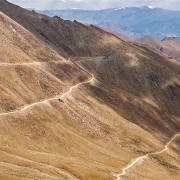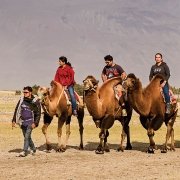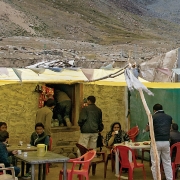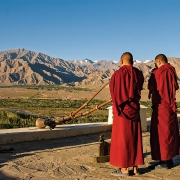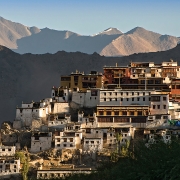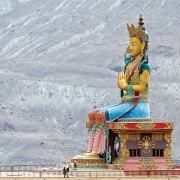
Etcetera
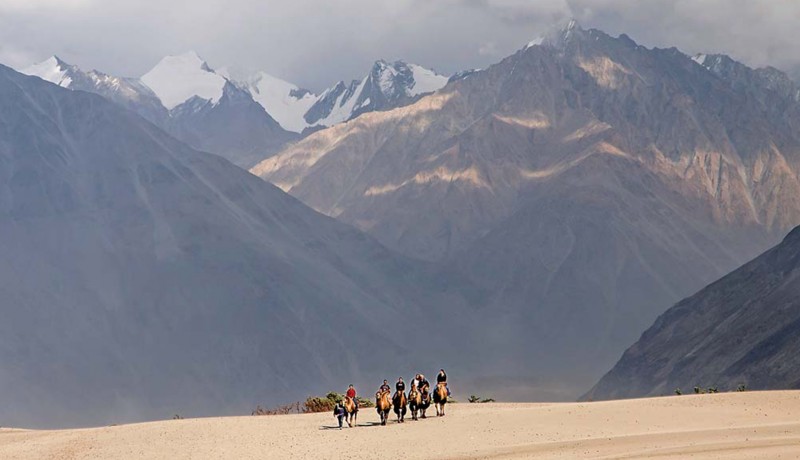
Breathtakingly beautiful Nubra Valley, the fruit orchard of Ladakh, nestles in the lap of mystical mountains
The enchanting Chamba Camp Thiksey in Ladakh was draped in a solitude so pure that it seemed like an earthly paradise of sorts. At a distance, Thiksey Monastery cascaded down a mountain slope like a whitewashed poem in stone. If the gods were to ever descend on earth, they would perhaps choose this spot as their base.
We were reluctant to leave our charmed environs for Nubra Valley but did so on the persuasion of the oracle of Thiksey, a mystic whom we met at her home near Leh. Her face, seemingly carved and hewn by harsh winds and adversity, much like the mountainous landscape of Ladakh, was alight with deep spirituality. In a trance punctuated by much hissing, muttering and chanting, she told us our wishes would be granted if we strung a prayer flag at the highest point that we could find and said a prayer at a hilltop monastery.
And so, one morning, we headed for Nubra Valley, north of Leh, which unfolds dramatically and in green splendour between the Karakoram and Ladakh ranges of the Himalaya. The valley is accessed by traversing the Khardung-La, one of the highest motorable passes in the world at 18,390 ft! We resolved to put up a prayer flag in those snow-hushed heights there.
Our car climbed out of Leh and the Indus Valley, traversing a lunar wasteland of brown, humped mountains slashed with shades of deep grey, pink and purple even as the clouds above cast a shadow on their rounded scalps. There were just a few cars on the curving asphalt road, underscoring our loneliness and insignificance amid the starkness.
The landscape unfolded like a thangka painting—muted, multilayered but, at times, brimming with colour. Mountains that resembled seismic knots, sometimes crumbly and slashed with frozen rivers of snow, clawed at an incredibly blue sky. Part of the ancient Silk Route, the deep valleys and high mountains with their seemingly impenetrable passes were traversed for centuries by vast caravans of wool and cloth, opium, spices, coral, turquoise and gold as part of a thriving trans-Himalayan trade between Leh and Yarkand (China).
On that drive, where we would clock 350 km in all, we felt we were suspended between earth and sky and halfway to heaven—vast blue skies dotted with scudding clouds as large as earthly ocean liners; the barren, desiccated landscape and a blazing sun created glowing indelible images while the sudden appearance of apricot and apple groves added dollops of colour. Ladakh is one of the last outposts where Tibetan Buddhism is still practised and its monastery-strewn landscape often made us feel we had left India behind.
We were gaining altitude, but having spent a week in Leh at 11,480 ft, we were not affected by the symptoms of high-altitude sickness such as a throbbing headache, fatigue or nausea. The air is thinner at high altitudes and if you go higher too quickly, the body cannot get enough oxygen and one tends to breathe faster. So our hosts at Chamba Camp had advised us to rest the first day to allow our bodies to get used to the rarefied air. Age, the sex of the person, etc, do not matter as much as taking it easy the first few days and avoiding alcohol altogether.
Having taken all the precautions, the drive to Nubra (average altitude 10,000 ft) turned out to be a breeze. After driving for 40 km, we arrived at Khardung-La where a signboard stated that the pass was the ‘highest motorable pass in the world’. Apparently, this fact is often contested, as Marmik La near PangongTso Lake is 200 ft higher.
Khardung-La is the ideal spot for the selfie-obsessed but we had a more important mission: planting our prayer flag in those Olympian heights. We climbed up a mound adorned with a huge forest of prayer flags waving their devotion to the wind and triumphantly planted our flag, while the wind whooshed in our ears. We stood there for what seemed like an eternity, taking in the astounding views of the Indus Valley while the peaks of the Zanskar range un-scrolled like a mighty accordion in the distance. The awesome Saser massif—a group of mountains—reared in the misty north like a mythical fire-breathing dragon.
Momentarily, we felt dizzy with elation and wonder. Warning signs at the pass urged travel- lers not to linger too long and report to the medical centre in case of nausea or vomiting. So we hopped back into our car and were back on the ribbon-like road that resembled a coiled anaconda disappearing into an abyss of nothingness. As our car lurched along, bikers vroomed past on their devil machines.
Near the town of Khalsar, the road forked and one arm led to the twin valleys of Nubra and Shyok rivers. The mountains parted to showcase a lovely fertile landscape, a far cry from the stunning barren aridity of the rest of Ladakh. This valley is also the fruit bowl of the region where apples, apricots, grapes and walnuts grow and flourish, and barley and wheat fields unfurl a green welcome.
In an oasis of poplar and willow trees snuggled a garden restaurant where we unpacked our picnic lunch. Snow-streaked mountains framed the vistas and looked down at us sternly. We could have tarried there endlessly—so beguiling were the views.
We finally arrived at Hunder village where we checked into a charming little place called Karma Inn built in traditional Ladakhi style. It was located a kilometre away from the sand dunes of Hunder where the double–humped Bactrian camels loped. After a brief rest, we drove to the other worldly expanse of the sand dunes of Hunder, edged by hunkering mountains where the camels slouched on the sands like the bankrupt potentates of a forgotten kingdom. They eyed us almost flirtatiously from behind long lashes, and most tourists rose to the bait of revelling in a slow loping ride on the sands.
Dusk fell, casting mysterious shadows on the valley floor and the un-scalable mountains seemed to create a barrier that no man could breach. Next morning, the contours of the landscape had softened and we rose to the sight of sunflowers with their faces upturned to a wan sun in the garden of Karma Inn. As we headed for Diskit, the valley had been transformed into a glistening green bowl. There, a lovely little monastery tumbled down a mountain slope in a jumble of whitewashed buildings with reddish-brown window panes. But what was more striking was a tall statue of the Maitreya or future Buddha, said to be one of the tallest in the region. Its eyes gazed at the beauteous landscape around it as though admiring his own creation.
We climbed up to the monastery via uneven steps and came upon an elderly monk who sat with eyes downcast; his red robes contrasted vividly with the stark barrenness around him. While chatting with us, he told us how, till 15 years ago, monks had to navigate a dizzying gorge to collect water from a spring. Today, water is pumped up but the monks still live simple lives steeped in prayer and meditation.
Within, the monastery was suffused with the fragrance of butter lamps and bright thangka paintings adorned the walls. We had a prayer said by a monk in the Gokhang or meditation area of the monastery, believed to be invested with a great deal of spirituality. The two requirements of the oracle of Thiksey had been fulfilled.
We returned to our inn to prepare to leave for Leh but heard deep-timbered voices rising in prayer to the blue sunlit sky as though to shake the heavens. A ceremony was in progress and 20 red-robed monks sat at low tables with bulky scriptures in their hands, chanting and humming.
We felt blessed as the prayers washed over us like showers of beneficent rain and resonated in our heads till we passed once again the heights of Khardung-La, back to the familiar comfort of Leh.
DEALING WITH HIGH ALTITUDE
Ladakh is a high-altitude desert and can pose problems such as altitude sickness. That, however, is no reason to be alarmed, provided you take the right precautions. If you intend to fly to Leh, make sure no activities are planned for the first 24 hours of your stay. Rest. Start exploring the following day but avoid anything too strenuous. After the first 48 hours, Ladakh is your playground. You will be on safer turf if you drive from Manali or Srinagar to Leh. This is because there is a gradual ascent, which allows your body to adjust to the altitude.
It is important to drink a lot of water: frequent little sips. The high-altitude desert (as any desert) can lead to dehydration. The main symptoms of altitude sickness are shortness of breath (the air is rarefied in the higher reaches), headache and a feeling of lightness in the head. If you experience any of these symptoms, stop, ease up, take a breather, rest. If it’s any reassurance, the authors (now in their mid-60s) have been to Ladakh twice—once by air and the second time by land—and faced no health problems. Yes, we did not push the buck (though we admit we were tempted to in this region of spectacular landscapes) and played by the rules.
FACTFILE
GETTING THERE
By air: There are a number of early morning flights from Delhi to Leh.
By road: One can travel by road to Leh from either Srinagar (434 km) or Manali (474 km). Driving to Leh, apart from the spectacular scenery, has the added advantage of slowly acclimatising the traveller to the rarefied heights of this enchanting region.
ACCOMMODATION
Leh has mid-range accommodation but the luxe Chamba Camp Thiksey is the top of the heap. It bills itself as the “ultimate travelling camp” as it travels to other destinations after the Ladakh season ends. (It is open from early June to end-September.)
TIPS
For Nubra (130 km from Leh), it’s best to hire a taxi from Leh. Many agencies in Leh offer the share-a-cab option too. While Hunder and Diskit have charming guesthouses and home stays, Karma Inn is a very comfortable mid-segment option. The best time to visit the region is between May and October. For more information, visit J&K Tourism at www.jktourism.org or www.chambacampthiksey.com
Text & Photos: Gustasp & Jeroo Irani Featured in Harmony — Celebrate Age Magazine October 2017
you may also like to read
-
Cracking the longevity code
Small yet impactful choices can be game-changers, writes Srirekha Pillai At 102, there’s no stopping Chandigarh-based Man Kaur, the world’s….
-
Home, not alone
While a regulatory framework is vital for senior-care facilities, the need of the hour is to develop an ecosystem to….
-
Birthday Girl
Published in a special edition to honour Japanese master storyteller Haruki Murakami’s 70th birthday, Birthday Girl (Penguin; Rs 100; 42….
-
A huge treat for music lovers
Published as the revised and updated second edition, Incomparable Sachin Dev Burman (Blue Pencil; Rs. 599; 470 pages) the authoritative….



